Yosemite in the Spring
- Krista Minard
- May 16, 2023
- 12 min read
Updated: Jan 17, 2025
Rushing waterfalls beckon visitors to Yosemite Valley, which is emerging from its long winter slumber.
Hikes by Phillip Reese

Anyone who has followed the weather knows what happened in Yosemite National Park this year. Mounds of snow fell, the park closed for three weeks, and the photos emerging of Curry Village made the tent cabins look like thick-frosted gingerbread houses. But at press time, the park was open—as were most roads in—and all that snowfall had turned the waterfalls into wild, roaring cascades of raw power.
The splendor of early-spring Yosemite might be surpassed only by later-spring Yosemite. But before jumping in the car, check the conditions. With 240% of average snowpack in the Tuolumne and Merced river watersheds as of April 1, Yosemite Valley could be overwhelmed by water between now and July as that snow melts. Between those fabulous falls and the rising river, there may be parts of the valley that are simply inaccessible. Check the park’s social media (IG: @yosemitenps) and website (nps.gov/yose) for the latest information before you go.
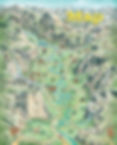
Yosemite Village

Yosemite Visitor Center and Theater, Yosemite Museum, Indian Village and The Ansel Adams Gallery make for enriching stops, revealing a wealth of information and history through exhibits, interactive signage and lots of artifacts. At the museum, a short, free film with stunning footage introduces folks to the splendor of the region. The Ansel Adams Gallery is packed full of Adams’ famous photography of Yosemite (and other beautiful wildlands) as well as works by other artists and photographers. The gallery also includes books, handcrafted items and gifts. The Village Store is fun to explore for souvenirs—coffee mugs, T-shirts, hats—and carries camping gear (forget your flashlight?) as well as groceries so you can create your own picnic to enjoy beside the Merced River. Also nearby, Degnan’s Kitchen makes towering sandwiches and typically has a crock of soup or chili going; you also can grab an espresso drink.
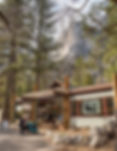
Valley Floor Tours
Let an expert tell you about Yosemite by participating in a valley floor tour. Take an open-air tram in good weather or a heated bus if it’s cold, and you’ll learn about the history of the park, as well as its rock formations, granite landmarks, flora and fauna. Each tour runs approximately two hours.

Must Do! PLAN YOUR TRIP For the past three years, reservations have been required to enter Yosemite National Park. Not so this year. Entrance fee is $35 and good for seven consecutive days, or get an annual pass for $70. You still should get reservations to stay overnight—campgrounds and lodges fill up fast once the spring and summer seasons get underway.
1. Mist Trail to Vernal and Nevada Falls

This is one of the most famous day hikes in America for good reason. The scenery is unmatched and the photo opportunities are abundant. But it is also a strenuous, 6.4-mile hike that gets very crowded and can even feel dangerous.
Get started at the Happy Isles Trailhead near shuttle stop #16. Cross the bridge and follow the signs. The paved trail climbs gradually at first for about 1 mile, where you will encounter a rustic footbridge. This is a great spot for a photo, with views of Vernal Fall to the east and the Yosemite Valley to the west. Many people stop and turn around here but, if you can, it is worth going farther.
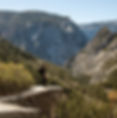
For the next ¾ mile, the trail steepens and narrows, with dirt and rock replacing pavement. Every step brings Vernal Fall more into view. You’ll likely start to feel the mist—the trail’s namesake.
The trail gets even steeper as you climb to the top of Vernal Fall. You will probably be amid dozens of others coming and going. Once again, Yosemite hiking requires your patience as you safely navigate uneven footing, steep inclines and lots of people. At the top of Vernal Fall is the peaceful Emerald Pool and more views of the valley. Some people will probably be swimming in the pool. You should not. People have died getting too close to the edge of the falls.
It’s another tough 1½ miles to Nevada Fall. If you can handle it, you will climb right beside the fall and then, at the top, you can take a rest and look out yet again over the valley.
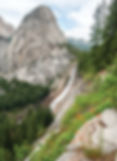
After summiting the falls, either go back the way you came or, for new scenery and fewer crowds, take the John Muir Trail back down, stopping for more big views at Clark Point. The trail intersects with the Mist Trail at the footbridge.
Climb Half Dome
It’s a hike—and then some! Experienced, well-prepped hikers can take the 14-mile-plus trek up Yosemite’s most iconic rock formation. It’s a gain of 4,800 feet in elevation, with the final push a grasping pull along cables that are typically placed in late May. (This year, it may be a little later.) It’s an enticing challenge with a spectacular payoff: panoramic views of the Yosemite Valley and High Sierra. But know your limits! The need for fitness and preparation cannot be overstated—people have to be rescued every year. Permits are required, and handed out via lottery; there’s a limit of 300 per day. Reservations for permits can be made at recreation.gov or by calling (877) 444-6777. Learn more at nps.gov/yose/planyourvisit/halfdome.htm.
2. Happy Isles Loop
This is a pleasant, short—but not dramatic—hike by the Merced River.
Take the free park shuttle to stop #16 or, for a longer walk, head southwest from Curry Village until you arrive at the Happy Isles Bridge.

Turn to the right to quickly arrive at the Happy Isles Art and Nature Center, which features a variety of exhibits, along with art workshops. Explore the area around the nature center and you will come across a nifty outdoor exhibit about rockfalls at Yosemite. The Merced River is close at hand, and there are tranquil spots on the small “isles” that give this area its name. If you double back after this little stroll, you’ll walk just over ½ mile.
You can also cross the bridge at stop #16 and then turn left to follow a flat, wide trail that follows the Merced River. While the surrounding trees offer cool shade, don’t expect to see much big mountain scenery on this hike. It is a peaceful walk through the woods.
The trail loops around the Upper Pines campground and then after about a mile deposits you back at the road, where you should have little trouble finding your way to the shuttle stop.
Curry Village

Of the 13 campgrounds in Yosemite, Curry Village is one of the most popular, with pitch your-own tent sites; a “glampground” with heated and nonheated tent cabins; hard-walled cabins (with or without bath); and rooms in the Stoneman House. The area also has a general store, mountaineering school, bike and raft rentals, several dining options, an ice cream shop, Peet’s Coffee, amphitheater and ranger programs. The on-site outdoor pool has been closed and will hopefully open in time for summer.
Yosemite Conservancy
The Yosemite Conservancy runs a number of programs, including art classes (watercolor, acrylic, journaling), naturalist-led walks, birding, stargazing, trail rehab, junior ranger activities and more.
Must Do! TAKE THE SHUTTLE The park operates a free shuttle within the valley and beyond. Hop on, hop off—it’s the easiest way to travel, and it delivers riders straight to all the favorite valley hot spots, including museums, visitors center, lodges, campgrounds, El Capitan and the meadow, Curry Village, Happy Isles and Mirror Lake.
STAY
INDOORS INSIDE THE PARK AND JUST OUTSIDE ITS BOUNDARIES, YOU’LL FIND COZY LODGES AND VACATION RENTALS FOR A COMFY NIGHT’S STAY. HERE ARE A FEW. MAKE SURE TO MAKE RESERVATIONS. AS SPRING DEEPENS, SO DO THE CROWDS.
The Ahwahnee
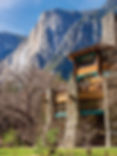
This landmark hotel has been closed for the past few months while undergoing a renovation for seismic stability, a kitchen overhaul and an update to its air-conditioning and heating system. Built in the 1920s on the site of a former Miwok village, with views of Half Dome, Glacier Point and Yosemite Falls, The Ahwahnee was designed for the affluent traveler, with luxurious Persian rugs, grand furniture, imposing beams and vast common areas with floor-to-ceiling windows and fireplaces tall enough to stand inside. It’s now on the National Register of Historic Places, and although it has been remodeled numerous times over the years, it still feels period-appropriate and lavish. Today’s decor leans more toward Native American chic, but several of the original rugs adorn the walls, and it’s no stretch to imagine guests dressed in 1930s popular butterfly sleeves and boleros. Reserve one of the rooms or suites in the main hotel or a cottage on the property. The majestic dining room was not yet open at press time; when you can (maybe as soon as July), go for dinner. It’s simply gorgeous.
Yosemite Valley Lodge

This centrally located lodge has 245 rooms and lots of amenities, including bike rentals available on-site. The lodge’s food court, Base Camp Eatery, supplies a broad variety of grub. Make the rounds for pizza, pasta, burgers, soups and premade salads. The controversial Starbucks—popular as it was—has closed, possibly permanently. Also at the lodge, the Mountain Room delivers terrific views of Yosemite Falls, and it has a menu that includes prime cuts of beef with classic sauces such as béarnaise, mushroom and blue cheese butter.
Stay Indoors
Rush Creek Lodge

Just outside park boundaries on Highway 120, Rush Creek Lodge is the newest addition to Yosemite’s indoor lodging options. Opened in 2016, it’s a beautiful property that lies about a 40-minute drive from Yosemite Valley and provides easy access to Hetch Hetchy. With 143 rooms, including villas that are spread throughout the compound, Rush Creek is well set up for couples or families: saltwater pools open 24/7, year-round; evening s’mores; a game room with pinball, pool, foosball and more; an outdoor play area with a doughnut swing, climbing tunnels, zip line and a fabulous hillside chute slide; and a dedicated recreation desk where you can sign up for activities including stargazing, arts and crafts and nature tours. Although the address for Rush Creek says Groveland, it’s actually 20-plus miles up the mountain from Groveland proper, and the only place around for miles. So its restaurants and tavern are convenient (the burgers and Philly cheesesteak are especially good!), and the general store comes in handy for snacks, over-the-counter medications, espresso drinks and plenty more (T-shirts, water bottles, locally made jewelry and artwork). One of Rush Creek’s best assets is its spa, which has been designed to replicate the Yosemite experience with waterfalls to sit beside and stand beneath, heated tile beds (like lying on sun-baked granite), an aromatherapy sensory room, a hot/cold shower, a 165-degree Himalayan salt dry sauna and a eucalyptus steam room that will clear your sinuses. The spa menu includes massages, magnesium foot soaks and other delights.
Tenaya at Yosemite

Just outside the park’s south entrance, the Tenaya lodge in Fish Camp has more than 300 rooms, plus some darling cottages where you can cozy up in seclusion. The two-bedroom Explorer Cabins opened a couple of years ago—they’re a fabulous option for families. Other pluses: the Ascent Spa, because nothing feels better after hiking than a moisturizing body treatment and massage, and several restaurants on-site. Also available, Yosemite 360 Tours are led by a knowledgeable guide and will take guests into the valley, Mariposa Grove and the Tuolumne high country once the snowpack melts.
Wawona Hotel

Away from the valley, 27 miles out on Highway 41, the pretty and historic Wawona Hotel was closed part of last season due to fire. The Victorian-era lodge has 104 rooms, a dining room, golf course, tennis courts, pool and horseback riding stables. Stay here and we promise you’ll see deer. Lots and lots of deer. Also in Wawona, the Yosemite History Center takes visitors back in time with its collection of historic buildings.
Mariposa Grove

Storm damage has closed this majestic grove of giant sequoias, but we believe it will open this season to allow visitors to forest bathe and admire the stately trees. In the southern portion of the park, it’s home to more than 500 mature giant sequoias and when open is accessible via shuttle from the Welcome Plaza near Yosemite’s south entrance (arrive early!) or a 2-mile hike (each way) on the Washburn Trail or Mariposa Grove Road. You cannot drive your own car unless you have a disability placard.
Must Do! WATCH FOR WILDLIFE The park encompasses 1,187 square miles, far more than just the valley, and within its boundaries live multitudes of deer, coyote, raccoons, rodents, birds and—wait for it—up to 500 black bears. They’re out, and they’re hungry. If you see one, stay at least 100 yards away. Keep food—and anything that looks like it could be food (sunscreen, for example)—out of your car and stored in one of the park’s bear-proof lockers. Watch for wildlife as you’re driving, too, and keep to the speed limit. This will help you stop in time should an animal pop out in front of your vehicle.
3. Tunnel View to Inspiration
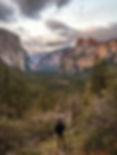
Point This 2.3-mile trail has gorgeous views of Yosemite Valley, El Capitan and Bridalveil Fall, but parking is often a challenge and the climb to the top is steep.
You’ll start at the famed Tunnel View lot on Wawona Road, where millions of photographs have been taken. It will be very crowded. Breathe deep, be patient and try to find a parking spot before heading up the trail to Inspiration Point.
The trail climbs about 1,000 feet over the course of 1.2 miles. The views, even more than the trail grade, are likely to slow your progress. There are gaps in the trees and overlooks throughout the trail that serve as great spots for rest and reflection.
Inspiration Point itself creeps up after you’ve walked about 30 minutes. It offers similar wonderful views as can be found next to the tunnel a mile south—but without the noise and stress of passing vehicles and buses.
Most people turn around here but, if you have more time, the Pohono Trail continues uphill for several more miles, regularly hitting famous points and overlooks.
4. Yosemite Falls

This is a spectacular but difficult 6.6-mile climb to the top of North America’s tallest waterfall, rising more than 2,500 feet from the Yosemite Valley floor.
The trail begins at Camp Four, near shuttle stop #7. The switchbacks start early—you’ll climb 1,000 feet to Columbia Rock in the space of just 1 mile, with sweeping views of the valley as your reward. This is often the most crowded part of the trail (many families attempt it with their children), so be patient as you navigate around fellow hikers.
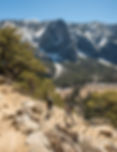
The next ¾ mile isn’t too hard. The trail flattens a lot and even curves downhill for a bit, until Upper Yosemite Fall dominates your line of sight. This is the highlight of the trip for many. Take your time and try to find a spot for photos and lunch. If you turn around here, then you will finish your hike in about four hours—or faster, if your pace is less leisurely.
For those continuing on, the next 1½ miles consist of brutal switchbacks and another 1,500 feet of elevation gain. Early in the climb, you’ll probably feel the cool mist from the falls.
The reward for reaching the top is panoramic views of the valley—and a sense of wonder about how modest-looking Yosemite Creek can feed such a massive waterfall.
Must Do! WATERFALLS

They’re flowing, in some cases past blobs of snow, and as the days warm up, they will really get to roaring. Yosemite Upper and Lower, Vernal, Nevada, Sentinal, Bridalveil, Horsetail . . . even some that haven’t run much in years will be on full display. This year promises to be spectacular—and dangerous. A variety of lookout points and hikes put visitors in close proximity to the falls. Stay vigilant, and don’t lose your life for a selfie.
Hetch Hetchy

Should you find yourself in the northwest corner of the park, take the drive into Hetch Hetchy. It’s a beautiful valley, flooded into a reservoir in 1923—with the construction of the O’Shaughnessy Dam—to supply water to the Bay Area (a controversy to this day). Photos of the Hetch Hetchy valley before the construction of the dam show its remarkable resemblance to the Yosemite Valley, with granite walls, waterfalls, forest-lined meadows and the Tuolumne River flowing through. More than 250 miles of hiking trails exist within the Hetch Hetchy area, ranging from the 2-mile round-trip trek to Lookout Point to a 29 mile multiday excursion on the Laurel/Vernon/Rancheria Loop. The Rancheria, Tueeulala and Wapama falls are all flowing now. Wilderness permits are required for all overnight hikes. Along the road to Hetch Hetchy, the 100-year-old Evergreen Lodge has 88 cabins in the woods and, like its sister property Rush Creek Lodge, maintains a restaurant, tavern and general store.
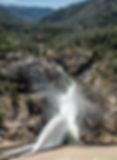
5. Mirror Lake Loop Trail
If you aren’t feeling up to a strenuous climb out of the valley but still want to spend much of the day hiking, this 4.4-mile trail is a popular choice.
Take the free park shuttle to stop #17 to reach the trailhead. Much of the hike is paved. Scenery is typical for the valley, with breaks in the massive trees offering occasional glimpses at the canyon rims.
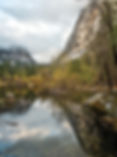
The trail is likely to be crowded. You’ll probably see many cyclists—they can ride most of the trail before parking near the lake.
Calling Mirror Lake a “lake” is a little generous. It’s more of a wide, calm place in the creek. Around May, it becomes a popular swimming hole. The relative lack of current—double check before you jump in—makes it a fun place for families to cool off while looking up at Half Dome.
You can either take the mostly paved trail back to the shuttle stop or opt for a slightly more rugged dirt trail that completes the loop.
